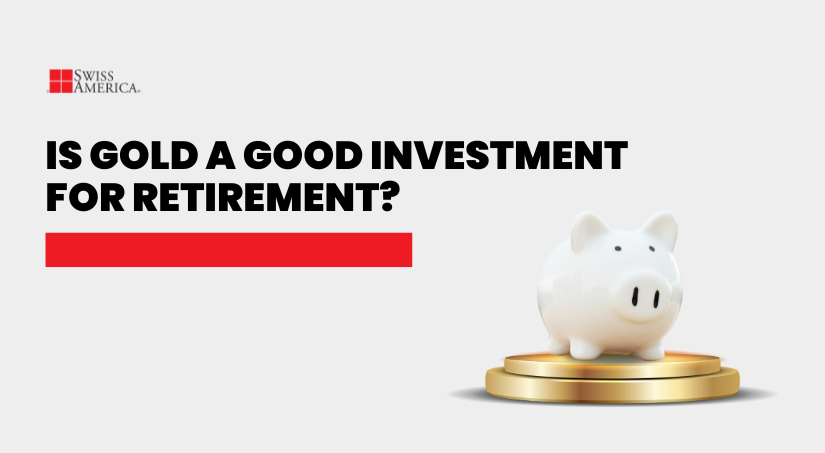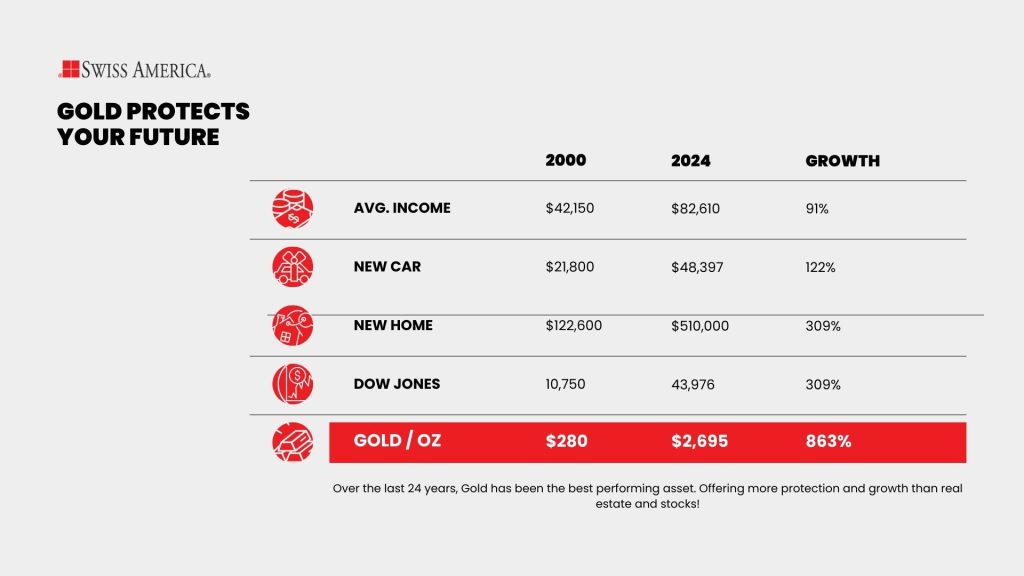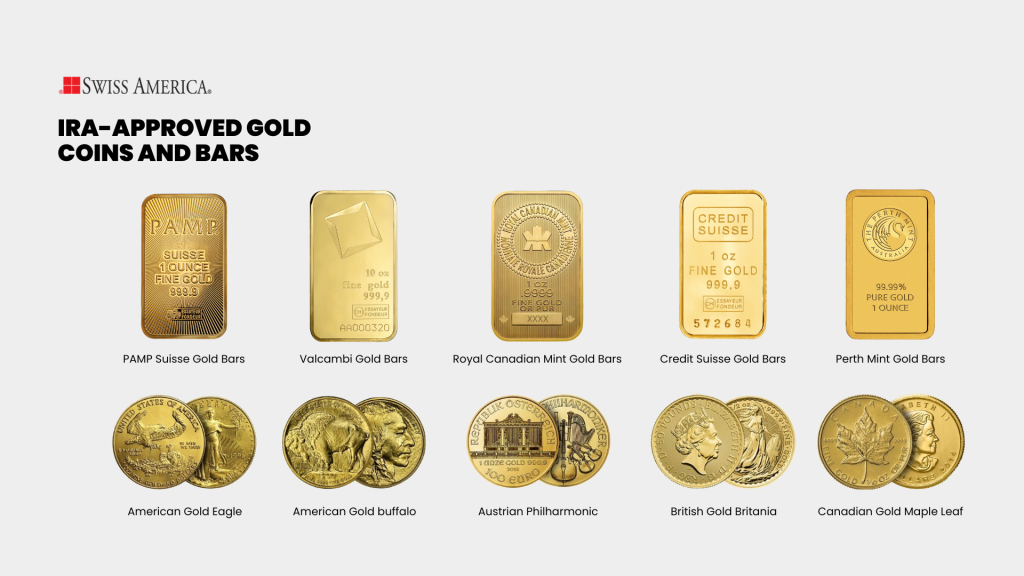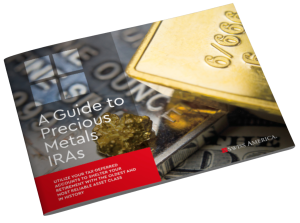
Is gold a good investment for retirement? For many people, it brings peace of mind. No one wants to lose their hard-earned money. Keeping everything in cash means inflation will chip away at your savings over time. That is where gold comes in.
From June 2020 to June 2025, the price of gold rose by 93%. Experts at JPMorgan Chase say that growth may reach $4000/oz by mid-2026. What is driving the rise? Economic uncertainty, inflation, tariffs, and global crises. These kinds of events push people toward gold because of its status as a safe haven that helps protect wealth.
This article walks through how to invest in gold as part of your retirement plan.
Benefits of investing in gold for retirement
People work hard their whole lives to save for retirement, and the last thing they want is to watch that money disappear in the ups and downs of the stock market. So a lot of investors look for something more solid. They turn to tangible assets that they can physically own and operate separately from the market.
That’s where gold comes in. It’s a way to diversify your portfolio, not rely entirely on the stock market, and protect against inflation.
Gold has a long history of holding value during uncertain times. Many people see it as a safe haven, which means they turn to it when things get shaky. Putting a portion of your portfolio into gold helps create a layer of protection around your savings.
You can invest in gold directly by buying it with cash or using retirement funds and rolling them into a Gold or precious metal IRA. That gives you the same tax advantages you get with a traditional IRA. And, depending on how the account is set up, you might even be able to take tax-free withdrawals.
Diversification and hedge against inflation
So, how does diversification and hedging against inflation actually work? A lot of advisors will recommend putting around 10%-15% of your portfolio in gold. Right there, you are spreading your wealth into an asset that does not move the same way as the stock market. If something happens in the market, gold often stays steady or even rises. It is a simple way to hedge your bets since it’s not correlated to other assets.
On the inflation side, you are buying gold at the current price. As the dollar weakens and it takes more money to buy goods and services, it also takes more money to buy gold. That means the value of your gold tends to rise with inflation, keeping your purchasing power intact while you hold it.

Tax advantages
If you use retirement funds to buy gold or other physical precious metals, there’s several tax advantages depending on your account type.
Traditional Gold IRA: Traditional Gold IRAs work just like regular traditional IRAs. You may be able to deduct your contributions, and the value of your metals grows tax-deferred. You won’t pay taxes until you take withdrawals starting at age 59.
Roth Gold IRA: If you set up a Roth IRA, you fund it with after-tax dollars. The value of your physical metals can grow over time, and your withdrawals in retirement are completely tax-free. Plus, you can always take out your original contributions without paying any taxes.
Approved precious metals for Gold IRAs
The IRS sets rules about what gold you can hold in your Gold IRA account. The goal of these rules is to protect investors from scams or bad investments. The allowed metals are high-quality and easily tradeable, so you can easily liquidate your retirement account if or when needed.
Gold coins and bars
Let’s start with purity. When you buy gold for one of these accounts, it has to be at least 99.5% pure. The one exception is the American Gold Eagle coin, which has a lower purity of 91.67%, but it is legal tender and the official gold coin of the United States.
As for form, you can buy gold bars or coins made by recognized government mints or accredited refiners and manufacturers. Coins have to be in brilliant uncirculated condition with no damage or defects. They also need to stay in their original packaging and come with certificates of authenticity.

Other precious metals
Gold isn’t your only option. You can also hold precious metals like silver, platinum, and palladium. IRA purity requirements for these metals include:
- Silver: 99.9%
- Platinum: 99.95%
- Palladium: 99.95%
Like gold, you can buy bars or coins from government mints or accredited refiners, assayers, or manufacturers. The good news is that your precious metals dealer can help guide you through the various options that make the most sense for your retirement account.
Funding a gold IRA
You have a few different ways to fund your physical gold IRA. You can add funds outright through a contribution, or you can transfer or roll over funds from a qualified retirement plan.
Contribution limits
The IRS sets annual contribution limits. For precious metals IRAs, you can contribute up to $7000 per year, or $8000 if you’re over 50. Depending on your situation, you might be able to deduct your traditional IRA contributions. That depends on your income, tax filing status, and whether you have a retirement plan at work.
Funding options
You can set up and fund one of these retirement accounts using your regular income, or you can transfer funds from an existing traditional IRA or 401(k). You can also do a rollover. If you go with a transfer or rollover, just know there are specific steps you need to follow to avoid tax penalties.
Gold IRA custodians and storage
Just like with traditional retirement accounts, an administrator handles record-keeping, reporting, and tax details. The same applies to precious metal IRAs. You’ll work with a Gold IRA custodian who manages the account and also helps you comply with IRS storage requirements.
Choosing a reputable custodian
You’ll want to choose a custodian with positive reviews and a long-standing track record. If you aren’t sure where to start, Gold IRA companies can make recommendations on companies they most often work with. For example, the Swiss America team often recommends Gold Star Trust.
Besides recommendations and reviews, also make sure you understand the custodian account fees and services available.
Storage options
You cannot store gold or other precious metals inside an IRA at home. Instead, your custodian sets up storage at an IRS-approved depository. Third-party storage offers several benefits, including insurance, physical security, and full compliance.
You also choose how to store your gold. You can have it commingled as part of a larger group, or choose segregated storage where the depository keeps your metals in a separate, designated space.
Risks and considerations
Like all investments, there are risks when you hold physical gold in your retirement account. The main risks of gold investing include market volatility, liquidity risk, and no income.
Market volatility
The value of gold can rise and fall, so it is best to treat it as a long-term investment. Over the past year, gold has done well due to economic uncertainty. Many government treasuries have been buying it to protect the value of their cash, and a lot of investors have turned to gold to guard against possible downturns.
There is no way to predict when or if precious metals will dip, so it is important to watch the overall market. That way, you avoid selling during low points and risking losses in your retirement portfolio.
Liquidity risks
When you decide to sell your gold bullion coins or bars, you may not be able to sell them quickly or at the price you want. Most precious metals dealers will buy metals from you, but they’ll pay less than the current spot price. This difference is the dealer premium or bid-ask spread.
No income
Gold is not an income-generating asset. You will not get dividends or cash flow from it. Consider it a defensive move to protect your portfolio. It is a lot like buying insurance, which gives you peace of mind.
Alternatives to Gold IRAs
You can also use your individual retirement account to purchase gold paper investments like gold stocks or ETFs. Let’s look at the pros and cons of the different options:
Gold stocks
Gold stocks mean you’re investing in a company that mines gold. The upside is that you might benefit when gold prices go up, and it’s a pretty liquid investment since it’s a paper asset traded on the stock market.
The downside is you’re counting on the company to run well and stay profitable. It’s not a tangible asset, and there’s more connection to the stock market compared to owning physical gold.
Gold ETFs
Gold ETFs invest in physical gold bullion using pooled assets. You are not buying the gold itself; instead, you own a digital unit in your brokerage account. The upside is that it’s a liquid investment and easy to sell. The downside is you’ll usually pay higher management fees compared to other types of gold investments.
Gold futures
Gold futures are a much riskier way to invest in gold. You do not own any gold. You are betting on a contract based on where you think the price will go, up or down. It is a highly speculative move. The upside is that you can use leverage, which is basically like gambling. The downside is that it is very time sensitive. You have to stay on top of it, and there is real potential to lose a lot of money.
Gold IRA costs and fees
There are a few different fees to consider if you’re using your retirement savings to buy precious metals.
Setup fees
The Gold IRA custodian has a setup fee to cover the administrative costs of establishing the account. The amount ranges from $50 to $500, depending on the complexity of your account.
Annual fees
There are also annual fees to manage your account and report details to the IRS. Annual fees can range from $50 to $500 per year. For example, Gold Star Trust’s yearly fees include:
- Maintenance fee: $90
- Commingled storage fee: $100
- Segregated storage fee: Varies by the depository
Other fees
The custodian you choose might also have fees for buying or selling precious metals within your retirement account. There might also be costs for other services like paper statements or wire transfers.
Gold IRA Fee Summary
| Fee type | Description |
| Account setup | One-time fee to set your account. |
| Annual maintenance fee | Recurring annual fee for account administration. |
| Segregated storage | Annual fee for storing your metals separately from others. |
| Non-segregated storage | Annual fee for storing your metals with other investors. |
| Buy, sell, exchange | Fee for buying, selling, or exchanging metals within your account. |
| Cashier’s check or wire transfer | Fees for funding logistics. |
| Various other fees like late fees, paper statements, termination fee, etc. | Various fees. |
Best Gold IRAs and Swiss America
As you look at gold and silver for your retirement account, consider Swiss America as your precious metals dealer. We’ve been in business for over 40 years and have helped thousands of happy investors buy precious metals to protect their wealth.
You’ll get expert guidance and ideas on the best metals to meet your investment goals. You can also check out our educational resources, like our Gold IRA kit, or our latest news about precious metals.
Final thoughts on Gold IRA investing
Most of the customers we work with buy gold for their retirement because they want some control. We cannot control government policies. We cannot control global conflict. We cannot control how investors react to the latest news that moves the stock market up and down. Gold gives you a way to take some of that control back.
No, you cannot predict what will happen with gold prices, and there are no guarantees. However, gold is an asset that tends to perform well during uncertain times. It gives you a chance to build some protection into your portfolio.
To learn more about getting started with a gold IRA, connect with the Swiss America team today!
Is gold a good investment for retirement: FAQs
What does Suze Orman say about investing in gold?
In a recent podcast episode, Suze Orman said she holds a small part of her portfolio in gold. She sees it as a helpful way to add stability and diversification.
What are the disadvantages of investing in gold?
Gold does not pay dividends or generate income, so one downside is missing out on that cash flow. Gold is more of a protection move, like buying insurance for your portfolio.
Is it wise to invest in gold for retirement?
It can be, depending on your goals and situation. Most personal finance experts recommend keeping a small percentage of your portfolio in gold for diversification.
The information in this post is for informational purposes only and should not be considered tax or legal advice. Please consult with your own tax professionals before making any decisions or taking action based on this information.
